Tucked away in Angels Gate Cultural Center is an unassuming, two-story army barrack.
Tan-colored paint peels from the exterior; rust speckles the handrails leading up to the door. It’d be easy to assume that the inside matches the outside — but upon entering the building, colorful railroad memorabilia line the walls, and Belmont Shore Model Railroad Club members chat happily together.
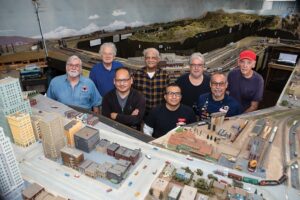
Belmont Shore Model Railroad Club members (l to r): Paul Dice, Edward Carfagno, Jay Chen, Don Marshall, Frank Hinojosa, Cameron Cast, Jessie Munoz, and Britt Wilde. (photo: John Mattera Photography)
They’ve turned the bottom floor of the barrack into a museum, lecture hall, and workshop, packed with soldering irons and railroad artifacts. Chuck Short, one of the longest-sustaining members of the club since its inception in 1972, has attended the group for decades. “Model railroading is a fun hobby,” he says. “You create something in miniature, something that’s real life from a bygone era.”
Belmont Shore Model Railroad Club is the nation’s oldest and largest N scale club, comprising more than 30 members from all over Los Angeles. Despite the name, the group has called San Pedro home since the early 1980s, after moving from their original spot in Belmont Shore. They’ve housed their pride and joy — the track — on the second floor of the barrack ever since.
“We invented the NTrak, which is the one that you see here,” says Short. “Dana, Jerry, Ben Davis, and I designed the first model, and we showed it at the 1973 MRIA [Model Railroad Industry Association] show.” The NTrak, a size of scale model with engines no larger than a saltshaker, revolutionized model railroading. “This way, people don’t need a whole room to put a layout,” he explains. “They can build a smaller module.”
Like the club, the hobby is much more than it seems. Far from going around in a circle, trains snake up and down hills, through towns, across bridges and rivers that are all modeled on the Southern California landscape of the 1950s. The track — which stands at chest height — immortalizes the buildings of yesteryear in balsa wood, paper mache, and other materials. “That particular building was in downtown Riverside, and it burned down,” says Jessie Munoz, a club member since the early 1980s. “All this stuff is gone, but we’re preserving history.”
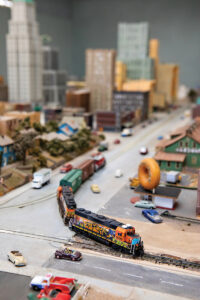
Inside the Belmont Shore Model Railroad Club. (photo: John Mattera Photography)
Preserving doesn’t do the masterwork justice. The landscape is alive with the ding of train crossings and the whistle of horns, which guests are invited to view up close. Though some elements were made with kits, others — such as the Point Fermin Lighthouse — were 3D printed, and most were made meticulously by hand. “At that time, we didn’t have the materials for a palm tree,” says Munoz, referring to the feathered canopy of a palm he made in the 1980s, “but my mom had parakeets.”
The trains are also works of art. Members usually buy standard engines from a manufacturer but often add their own flair. Munoz airbrushed graffiti onto one of his locomotives to match what he’d seen in real life, while Don Marshall modified the inside of his engine with lights that he can turn on and off with an app. Sam Antell added the whistle his steam engine would have blown in its time by finding the sound file online and uploading it to his locomotive. Short even built an entire train from scratch. “The train there is a military train from World War II,” says Short. “I’ve got close to four years of work in it, and it’s gotten major awards.”
Aside from making landscape and train modifications, members also maintain the setup’s electronics. Trains are powered by the track, which is connected to an electrical system underneath the platform. Dana Zimmerli, an engineer and co-inventor of the NTrak, teaches lectures on electrical engineering and computer programming to members every month. Munoz marvels at the collaboration that the setup demands. “It’s not just one talent here,” he explains. “You’ve got people building branch work, which is woodworking. You have people building scenery, which is artwork, and you have people crawling around underneath the darn things, trying to fix all the electrical problems.”
At scale speed, it takes 45 minutes for a train to complete a lap around the track. To keep things interesting, the club performs “switches” along the way that mimic what the engines would do in real life. When a switch happens — when a train reaches a yard and must unload its cargo — its owner must guide it off the track, unload the cars, load the new ones, and send it on its way in a coordinated manner that ensures no engines will collide. According to Munoz, switching is one of the best parts of the hobby. “There’s a lot of coordination that needs to happen. When you go in circles, you get bored,” he says. “Add some switches to it, you make it more exciting — add a lot more switches to it, you make it challenging.”
The club is not without its fair share of difficulties, however. Engines cost anywhere between $50 and $150, which can be prohibitive for those on a fixed income. To keep costs down, the group owns numerous locomotives that are free for members to use, and they charge a small monthly membership fee of $20. Other challenges, however, are not so easy to solve. With so few young members – who are difficult to recruit – the club hasn’t had the manpower to repaint their barrack. They also mourn those who’ve passed. “Last year was the worst,” says Short. “Four people passed away in the club. We’ve lost a lot of our friends over the last few years.”
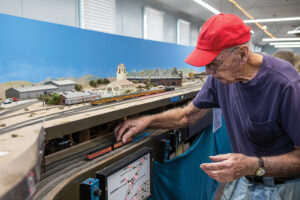
Wilde shows the inner workings of the model railroad set. (photo: John Mattera Photography)
But they forge on. In preparation for the model railroad conference in 2024, where they’ll host enthusiasts from across the U.S., they aim to complete their track’s scenery. That means building out the last and longest-in-work section: San Pedro. Tim Gutowski, an architecture student, is working on a model of Warehouse One, complete with structurally accurate lion’s head drainpipes the size of pinheads. “You join initially just to run trains, but then you start wanting to contribute stuff,” says Tim. “Especially with our San Pedro harbor project, we’re going to be using a lot of 3D printing to make cranes.”
For the club’s youngest members, the marvel lies not in the drainpipes, the tech, or the switches, but in the simple wonder of locomotives. “I like it because it’s a train, and it has a horn,” says Roberto Huaman, 12, who joined the club two months ago with his brother Jose. “You get to explore this area with the train, and you get to imagine stuff with the train.” Older members certainly agree with that. “You get lost in your imagination,” says Munoz. “The biggest thing I tell people is that it’s called a hobby, but as children, we called it playing with trains. You get to play again and call it a hobby.”
With that joy in mind, it’s no surprise that Munoz considers the club’s greatest success to lie in the simple things. “I like to see the excitement of the next generation getting into it, because it’s not just the membership or the club that’s important — it’s the friendship,” he says. “These guys are like family. Even on non-club days, we’ll hang out together, and we’ll go watch trains or just have a road trip together.” Sam Antell agrees. “I think the initial thing that brings people here is the fascination with trains, the scale models, and everything,” he says. “But what keeps us coming back is our community.” spt
Belmont Shore Model Railroad Club is located at Angels Gate Cultural Center (3601 S. Gaffey St., Bldg. 824). Hours are Tues. 7-9 p.m. and Sat. 12-4 p.m. For more info, call (310) 831-6262 or visit belmontshorerr.com.

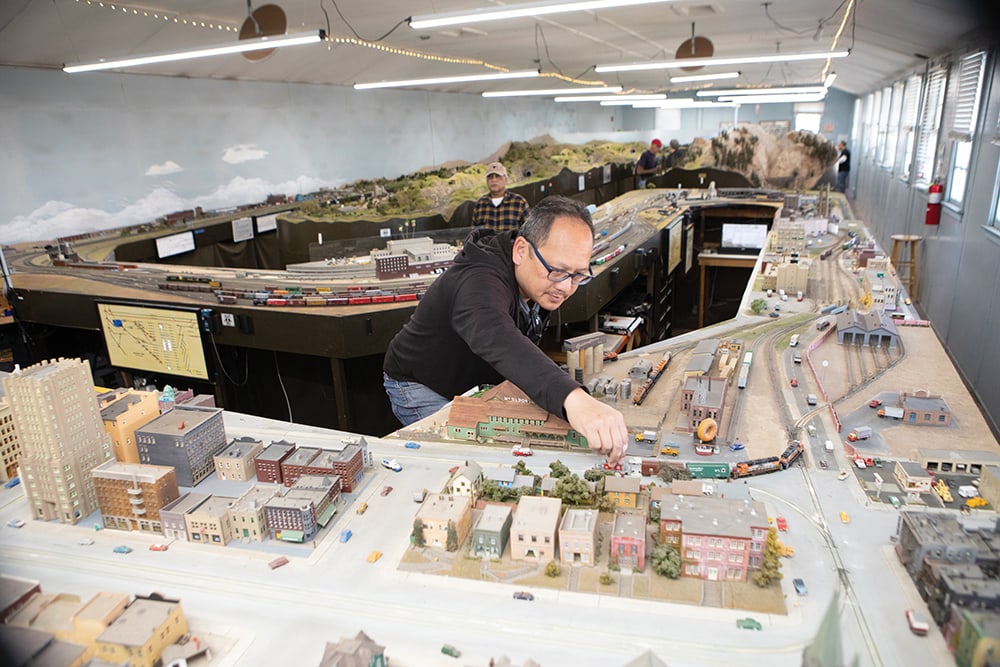
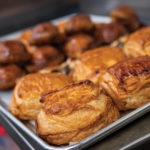
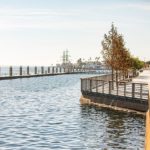
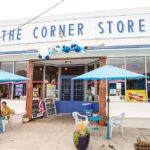
Comments